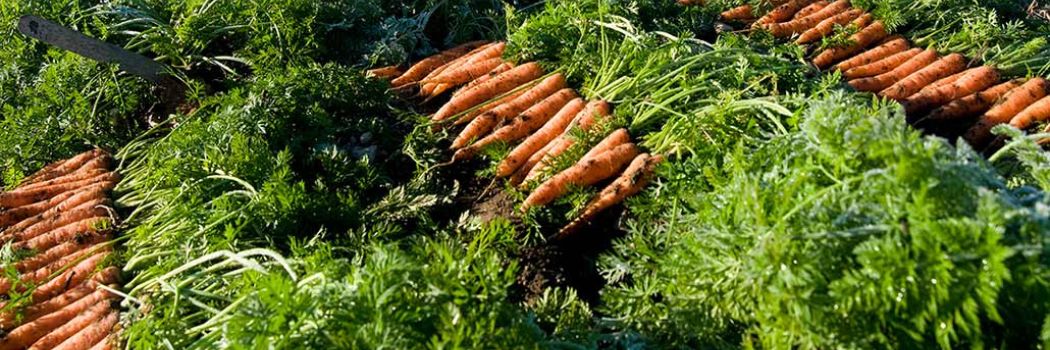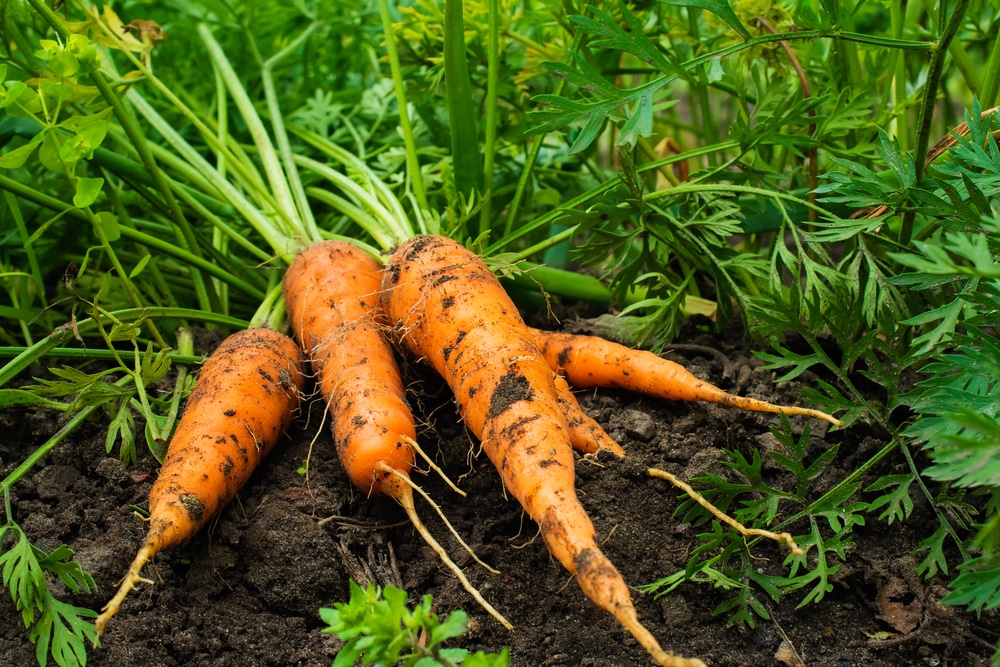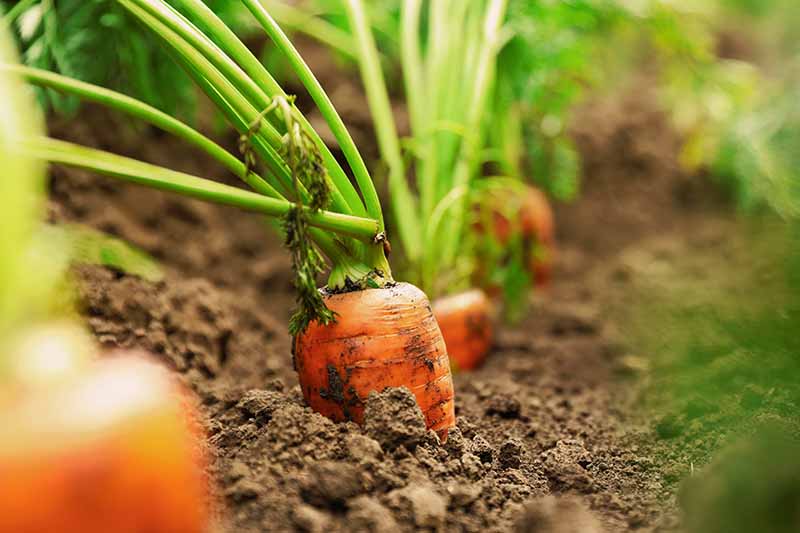Why Timing is Everything in Carrot Harvesting
Harvesting carrots at the right time is crucial to ensure optimal flavor, texture, and nutritional value. Carrots that are harvested too early or too late can be disappointing, with a lackluster taste and unappealing texture. To determine the ideal harvest time, it’s essential to understand the growth cycle of carrots and the factors that influence their maturity.
Carrots are a cool-season crop, which means they thrive in temperate climates with moderate temperatures. As they grow, carrots undergo a series of physical changes that signal their readiness for harvest. By monitoring these changes, gardeners can determine the perfect moment to pluck their carrots from the soil.
So, how to tell if a carrot is ready to harvest? The answer lies in observing the visual cues and using techniques to check for maturity. By doing so, gardeners can enjoy a bountiful harvest of crunchy, sweet, and nutritious carrots. In the following sections, we’ll delve into the visual signs of carrot readiness, methods for checking maturity, and other essential factors to consider when harvesting carrots.
Timing is everything when it comes to harvesting carrots. If carrots are harvested too early, they may be small and lack flavor. On the other hand, if they are harvested too late, they may become woody and fibrous. By understanding the optimal harvest time, gardeners can avoid these common pitfalls and enjoy a successful carrot harvest.
Carrots are typically ready to harvest between 60 to 70 days after sowing, depending on the variety. However, this timeframe can vary depending on factors such as weather, soil quality, and the specific growing conditions. By monitoring the carrots’ progress and using the techniques outlined in this article, gardeners can determine the perfect moment to harvest their carrots.
Visual Cues for Carrot Readiness
One of the most effective ways to determine if a carrot is ready to harvest is to observe its visual cues. Carrots that are ready to harvest will typically have a few distinct characteristics, including size, color, and shape.
Size is an important factor in determining carrot readiness. Most carrot varieties will be between 1/2 to 1 inch in diameter when they are ready to harvest. However, some varieties can grow larger or smaller, so it’s essential to check the specific variety’s guidelines. To check the size, gently dig around the carrot with your fingers or a tool, being careful not to damage the carrot.
Color is another visual cue to look for. Carrots that are ready to harvest will typically have a vibrant orange color, although some varieties may have a different color, such as yellow or purple. Avoid carrots that have a green or white tint, as they may not be fully mature.
Shape is also an important factor in determining carrot readiness. Carrots that are ready to harvest will typically be straight and smooth, with no signs of forking or branching. Avoid carrots that are misshapen or have visible signs of damage.
To inspect the carrot without damaging it, gently dig around the carrot with your fingers or a tool, being careful not to touch the carrot itself. This will allow you to see the carrot’s size, color, and shape without causing any damage. If the carrot looks ready to harvest, you can then carefully dig it up and inspect it further.
By observing these visual cues, you can determine if a carrot is ready to harvest and enjoy a crunchy, sweet, and nutritious snack. Remember to always handle the carrots gently to avoid damaging them, and to store them properly to maintain their quality and freshness.
How to Check for Carrot Maturity
Checking for carrot maturity is a crucial step in determining if a carrot is ready to harvest. There are several methods to check for carrot maturity, including the “tug test” and the “scratch test”. These methods can help gardeners determine if a carrot is ready to harvest, without damaging the carrot.
The “tug test” involves gently tugging on the carrot to check its resistance. If the carrot comes out of the ground easily, it is likely ready to harvest. However, if it resists being pulled, it may not be fully mature. To perform the “tug test”, follow these steps:
1. Locate the carrot and gently grasp the top of the carrot with your fingers.
2. Slowly and gently tug on the carrot, being careful not to pull too hard.
3. If the carrot comes out of the ground easily, it is likely ready to harvest.
The “scratch test” involves scratching the surface of the carrot to check its color and texture. If the carrot is ready to harvest, the scratched area will be a vibrant orange color. To perform the “scratch test”, follow these steps:
1. Locate the carrot and gently scratch the surface with your finger or a tool.
2. Observe the color and texture of the scratched area.
3. If the scratched area is a vibrant orange color, the carrot is likely ready to harvest.
By using these methods, gardeners can determine if a carrot is ready to harvest and enjoy a crunchy, sweet, and nutritious snack. Remember to always handle the carrots gently to avoid damaging them, and to store them properly to maintain their quality and freshness.
It’s also important to note that different carrot varieties may have different maturity times, so it’s essential to check the specific variety’s guidelines for harvest time. By combining these methods with visual cues and understanding carrot varieties, gardeners can ensure a successful carrot harvest.
Understanding Carrot Varieties and Their Harvest Times
Carrots come in a variety of shapes, sizes, and colors, each with its own unique characteristics and harvest times. Understanding the different carrot varieties and their harvest times is crucial to ensure a successful harvest. In this section, we will explore some popular carrot varieties and their typical harvest times.
One of the most popular carrot varieties is the ‘Nelson’ carrot, which is known for its sweet and crunchy texture. The ‘Nelson’ carrot typically takes around 60-70 days to mature and is ready to harvest when it reaches a diameter of about 1/2 inch.
Another popular variety is the ‘Little Finger’ carrot, which is a slender and sweet variety that takes around 50-60 days to mature. The ‘Little Finger’ carrot is ready to harvest when it reaches a diameter of about 1/4 inch.
The ‘Danver’ carrot is a popular variety that is known for its large size and sweet flavor. The ‘Danver’ carrot typically takes around 70-80 days to mature and is ready to harvest when it reaches a diameter of about 1 inch.
Other popular carrot varieties include the ‘Thumbelina’, ‘Parisienne’, and ‘Atomic Red’ carrots, each with its own unique characteristics and harvest times. By understanding the different carrot varieties and their harvest times, gardeners can ensure a successful harvest and enjoy a crunchy, sweet, and nutritious snack.
It’s also important to note that carrot varieties can be classified into different categories, such as ‘early’, ‘mid-season’, and ‘late’ varieties, based on their maturity times. Early varieties typically take around 50-60 days to mature, while mid-season varieties take around 60-70 days, and late varieties take around 70-80 days.
By choosing the right carrot variety for your climate and harvest time, you can ensure a successful harvest and enjoy a delicious and nutritious snack. Remember to always check the specific variety’s guidelines for harvest time and to use the methods outlined in this article to determine if your carrots are ready to harvest.
The Role of Weather in Carrot Harvesting
Weather conditions play a significant role in carrot growth and harvest time. Temperature, rainfall, and sunlight can all impact the development of carrots, and understanding how to adjust harvest times based on weather conditions is crucial for a successful harvest.
Temperature is one of the most critical weather factors affecting carrot growth. Carrots prefer cooler temperatures, typically between 60-70°F (15-21°C), to grow and mature. If the temperature is too high, carrots can become deformed or develop off-flavors. On the other hand, if the temperature is too low, carrots may not mature properly.
Rainfall is another essential weather factor to consider when harvesting carrots. Carrots need consistent moisture to grow, but excessive rainfall can cause them to become waterlogged and rot. If the soil is too dry, carrots may not develop properly, leading to a disappointing harvest.
Sunlight is also crucial for carrot growth. Carrots need full sun to partial shade to mature, but excessive sunlight can cause them to become bitter or develop off-flavors.
To adjust harvest times based on weather conditions, gardeners can use the following tips:
1. Check the weather forecast before harvesting carrots. If a heatwave or excessive rainfall is predicted, it may be best to delay harvesting until the weather improves.
2. Monitor soil moisture levels. If the soil is too dry, it may be necessary to water the carrots before harvesting.
3. Provide shade for carrots during extreme heatwaves. This can help prevent them from becoming deformed or developing off-flavors.
4. Harvest carrots during the cooler part of the day. This can help prevent them from becoming damaged or developing off-flavors.
By understanding the role of weather in carrot harvesting and adjusting harvest times accordingly, gardeners can ensure a successful harvest and enjoy a crunchy, sweet, and nutritious snack.
Common Mistakes to Avoid When Harvesting Carrots
Harvesting carrots can be a rewarding experience, but it can also be disappointing if mistakes are made. Here are some common mistakes to avoid when harvesting carrots:
1. Harvesting too early: Carrots that are harvested too early may not have developed their full flavor and texture. To avoid this, make sure to check the carrot’s size, color, and shape before harvesting.
2. Harvesting too late: Carrots that are harvested too late may become over-mature and develop off-flavors. To avoid this, make sure to check the carrot’s size, color, and shape regularly and harvest them when they are ready.
3. Damaging the carrot: Carrots can be easily damaged during harvesting, which can affect their quality and freshness. To avoid this, use a garden fork or a specialized carrot harvester to gently loosen the soil around the carrot before lifting it out.
4. Not handling carrots carefully: Carrots can be easily bruised or damaged during handling, which can affect their quality and freshness. To avoid this, handle carrots carefully and avoid dropping them or subjecting them to excessive pressure.
5. Not storing carrots properly: Carrots can be stored for several weeks if they are handled and stored properly. To avoid this, make sure to store carrots in a cool, dark place with good ventilation and keep them away from moisture.
By avoiding these common mistakes, gardeners can ensure a successful harvest and enjoy a crunchy, sweet, and nutritious snack. Remember to always check the carrot’s size, color, and shape before harvesting and handle them carefully to maintain their quality and freshness.
In addition to avoiding these mistakes, gardeners can also use the following tips to ensure a successful harvest:
1. Use a garden fork or a specialized carrot harvester to gently loosen the soil around the carrot before lifting it out.
2. Handle carrots carefully and avoid dropping them or subjecting them to excessive pressure.
3. Store carrots in a cool, dark place with good ventilation and keep them away from moisture.
4. Check the carrot’s size, color, and shape regularly and harvest them when they are ready.
By following these tips and avoiding common mistakes, gardeners can ensure a successful harvest and enjoy a delicious and nutritious snack.
Tools and Techniques for Harvesting Carrots
Harvesting carrots requires the right tools and techniques to ensure a successful and efficient process. Here are some of the most common tools and techniques used for harvesting carrots:
Garden Forks: Garden forks are a popular tool for harvesting carrots. They are designed to gently loosen the soil around the carrot, making it easy to lift out. To use a garden fork, simply insert the tines into the soil around the carrot and gently rock the fork back and forth to loosen the soil.
Trowels: Trowels are another common tool used for harvesting carrots. They are designed to scoop up the carrot and surrounding soil, making it easy to lift out. To use a trowel, simply insert the blade into the soil around the carrot and gently scoop up the carrot and surrounding soil.
Specialized Carrot Harvesters: Specialized carrot harvesters are designed specifically for harvesting carrots. They typically consist of a long handle with a curved or angled blade that is designed to scoop up the carrot and surrounding soil. To use a specialized carrot harvester, simply insert the blade into the soil around the carrot and gently scoop up the carrot and surrounding soil.
Other Techniques: In addition to using the right tools, there are several other techniques that can be used to harvest carrots. One technique is to use a gentle pulling motion to loosen the carrot from the soil. Another technique is to use a twisting motion to loosen the carrot from the soil.
Regardless of the tool or technique used, it’s essential to handle carrots carefully to avoid damaging them. Carrots can be easily bruised or damaged during harvesting, which can affect their quality and freshness.
By using the right tools and techniques, gardeners can ensure a successful and efficient harvest. Remember to always handle carrots carefully and avoid damaging them during harvesting.
Post-Harvest Care for Carrots
Proper post-harvest care is essential to maintain the quality and freshness of carrots. After harvesting, carrots should be handled carefully to avoid bruising or damaging them. Here are some tips for post-harvest care:
1. Store carrots in a cool, dark place: Carrots should be stored in a cool, dark place with good ventilation. This will help to slow down the respiration process and keep the carrots fresh for a longer period.
2. Keep carrots away from moisture: Carrots should be kept away from moisture to prevent rot and decay. If the carrots are wet, they should be dried thoroughly before storing.
3. Store carrots in a breathable container: Carrots should be stored in a breathable container, such as a paper bag or a mesh bag, to allow for airflow and prevent moisture buildup.
4. Monitor carrot temperature: Carrots should be stored at a consistent temperature between 32°F and 40°F (0°C and 4°C). Avoid storing carrots near heating vents or radiators.
5. Handle carrots gently: Carrots should be handled gently to avoid bruising or damaging them. Avoid dropping or throwing carrots, as this can cause damage and affect their quality.
By following these tips, gardeners can ensure that their carrots remain fresh and of high quality for a longer period. Proper post-harvest care is essential to enjoy the full flavor and nutritional benefits of carrots.
In addition to these tips, gardeners can also consider the following:
1. Use a root cellar: A root cellar is a great place to store carrots, as it provides a cool, dark, and humid environment that is ideal for storing carrots.
2. Store carrots in sand: Storing carrots in sand can help to keep them fresh for a longer period. The sand helps to absorb moisture and keep the carrots dry.
3. Use a carrot keeper: A carrot keeper is a specialized container that is designed to store carrots. It provides a cool, dark, and humid environment that is ideal for storing carrots.
By using these methods, gardeners can enjoy their carrots for a longer period and maintain their quality and freshness.








